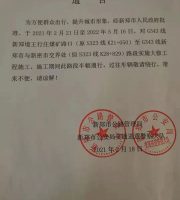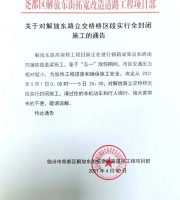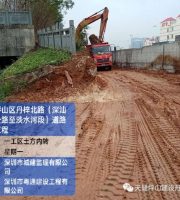Some provisions are even found to be a trap.
Resulting in the construction site not having or not fully having construction conditions; 4) The Owner fails to connect the water, electricity, and telecommunications lines required for construction from outside the construction site to the agreed location as specified in the contract, or although connected to the agreed location, it does not guarantee the needs during the construction period; 5) The Owner has not opened the passageway between the construction site and urban and rural public roads or the main traffic arteries within the construction site in accordance with the contract, has not met the needs of construction transportation, and has not ensured smooth flow during the construction period; 6) The Owner fails to provide the Contractor with engineering geology and underground pipeline network route information of the construction site in a timely manner as agreed in the contract, or the data provided does not meet the requirements of authenticity and accuracy; 7) The Owner’s failure to timely handle various certificates and approvals required for construction, as well as the application and approval procedures for temporary land use, road occupation, and railway dedicated lines, which affects the construction; 8) The Owner did not timely submit the benchmark and coordinate control points to the Contractor in writing; 9) The Owner failed to organize relevant units and contractors to conduct joint review of drawings in a timely manner, and failed to conduct design conversations with the contractors in a timely manner; 10) The Owner did not properly coordinate and handle the protection of underground pipelines and adjacent buildings and structures around the construction site, which affected the smooth progress of construction; 11) The Owner fails to provide the construction materials and mechanical equipment that should be provided by the Owner in accordance with the contract; 12) The Owner delays in assuming the responsibilities specified in the contract, such as delaying the approval of drawings, delaying the acceptance of concealed works, and delaying the response to questions raised by the Contractor, resulting in construction delays; 13) The Owner fails to pay the project funds according to the time and quantity specified in the contract; 14) The Owner requires expediting; 15) The owner occupies part of the permanent works in advance; 16) Economic losses caused by changes in the construction plan made by the owner midway, such as heavy relocation of construction forces, overstocking and reshipment of components and materials, personnel and machinery slowdown, extension of the contract period, increased project maintenance and on-site security work, and increased sales of temporary construction facilities and materials; 17) Expenses incurred due to the lack of quality certificates for the materials supplied by the Owner, the entrustment of the Contractor to conduct inspections on behalf of the Owner, or the re inspection of the materials and components that have been certified as qualified and the concealed works that have been inspected as required by the Owner; 18) Increased loss of quantity difference due to excessive construction consumption due to insufficient square footage, tons, quantities, or design modulus of materials provided by the Owner that do not conform to the geometric dimensions of the approved products of the designated manufacturer; 19) The cost of transporting materials and equipment supplied by the Owner that are not stacked at the location specified in the contract, or the labor and mechanical shift costs incurred when the Owner supplies them to the site and the Contractor unloads and stacks them on behalf of the Owner.
1) Economic losses caused by exceeding the original bid price or contract package price after winning the bid due to errors, omissions, or discrepancies in the bidding documents provided by the owner; 2) The Owner fails to deliver the construction site in accordance with the contract; 3) The owner failed to handle land acquisition, compensation for young crops and trees, house demolition, removal of ground, overhead, and underground obstacles within the period specified in the contract.
The owner’s actions potentially pose a claim opportunity.
1.
3、 Design changes potentially pose a claim opportunity 25) Loss of manpower, materials, and funds, as well as downtime for drawings, construction delays, repair and reinforcement, component material backlog, replacement, and other associated losses caused by design omissions or changes; 26) Losses caused by impact on construction due to inconsistency between the engineering geological exploration report provided by the design and the actual situation; 27) Additional costs incurred by taking remedial measures for technical treatment with the consent of the owner if design errors or defects are found after construction according to the drawings; 28) Additional costs arising from the temporary decision of the design representative on the site, but without formal written procedures, for the substitution of certain materials, partial modifications, or other random handling matters related to the project; 29) Increased costs for trial production and testing of new and special materials and new special structures; 30) Omissions and defects in many aspects such as unclear expression of construction instructions, unclear representation of names, specifications, and models of equipment and materials, or incorrect engineering quantities.
5、 Changes in construction conditions and methods potentially pose claims opportunities 35) Additional costs such as increased labor resources, turnover materials, mechanical equipment, and increased workload due to cross interference among various types of work caused by accelerated construction; 36) Overhaul expenses incurred due to the increase in transportation distance within the site due to the narrow site; 37) Reduced efficiency losses and increased safety protection due to construction in special environments or harsh conditions.
31) The terms of the contract are ambiguous and inaccurate; There are loopholes in the terms of the contract, which do not anticipate and stipulate the actual situation that may occur, and some essential provisions are missing; 33) There are contradictions between contract terms; 34) There are significant risks implicit in certain provisions of both parties, which are too harsh on unilateral requirements and uneven constraints.
Labor insurance and construction expenses; 38) When implementing the construction organization design and progress plan approved by Party A, the increased costs caused by changes in construction methods due to changes in actual conditions.
.
Source: 51 opportunities for online claims.
2、 Potential training opportunities for the behavior of the owner’s representative 20) The specific management personnel appointed by the owner’s representative did not notify the contractor in advance according to the contract provisions, which had an impact on the construction; 21) The instructions and notices issued by the owner’s representative are incorrect; 22) The Owner’s Representative fails to provide instructions, approvals, drawings, or perform other obligations to the Contractor in a timely manner in accordance with the Contract; The Owner’s representative unreasonably interferes with the Contractor’s construction organization; 24) The Owner’s representative conducts rigorous inspections of the project, repeatedly inspects the same part, uses inspection standards that do not comply with the contract provisions, conducts excessively frequent inspections, and intentionally fails to timely inspect.
4、 The defects in the contract documents may arise from claims opportunities.



